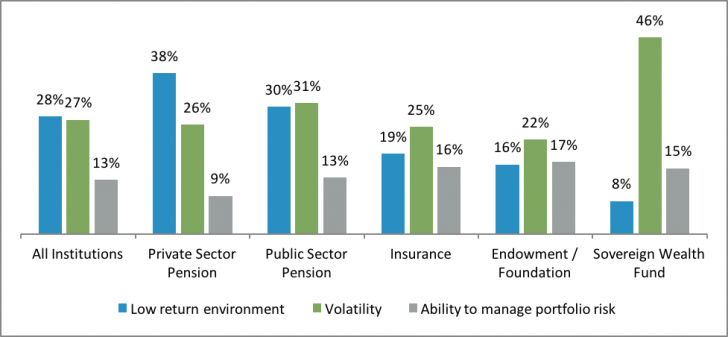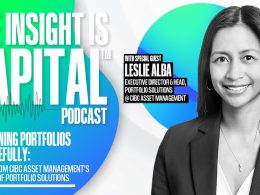by Fidelity Canada InstitutionalSM
With More Asset Allocation Changes Expected Globally, Institutional Investors May Find Value in Examining the Rigor of their Investment Decision-Making Process
TORONTO, December 1, 2016 - Institutional investors worldwide are expecting to make more asset allocation changes in the next one to two years than in 2012 and 2014, according to the new Fidelity® Global Institutional Investor Survey. Now in its 14th year, the Fidelity Global Institutional Investor Survey is the world’s largest study of its kind examining the top-of-mind themes of institutional investors. Survey respondents included 933 institutions in 25 countries with $21 trillion in investable assets.
The anticipated shifts are most remarkable with alternative investments, domestic fixed income, and cash. Globally, 72 percent of institutional investors say they will increase their allocation of illiquid alternatives in 2017 and 2018, with significant numbers as well for domestic fixed income (64 percent), cash (55 percent), and liquid alternatives (42 percent).
However, institutional investors in some regions are bucking the trend seen in other parts of the world. Many institutional investors in the U.S. are, on a relative basis, adopting a wait-and-see approach. For example, compared to 2012, the percentage of U.S. institutional investors expecting to move away from domestic equity has fallen significantly from 51 to 28 percent, while the number of respondents who expect to increase their allocation to the same asset class has only risen from 8 to 11 percent.
“With 2017 just around the corner, the asset allocation outlook for global institutional investors appears to be driven largely by the local economic realities and political uncertainties in which they’re operating,” said Scott E. Couto, president, Fidelity Institutional Asset ManagementSM. “The U.S. is likely to see its first rate hike in 12 months, which helps to explain why many in the country are hitting the pause button when it comes to changing their asset allocation.”
“Institutions are increasingly managing their portfolios in a more dynamic manner, which means they are making more investment decisions today than they have in the past. In addition, the expectations of lower return and higher market volatility are driving more institutions into less commonly used assets, such as illiquid investments,” continued Couto. “For these reasons, organizations may find value in reexamining their investment decision-making process as there may be opportunities to bring more structure and accommodate the increased number of decisions, freeing up time for other areas of portfolio management and governance.”
Primary concerns for institutional investors
Overall, the top concerns for institutional investors are a low-return environment (30 percent) and market volatility (27 percent), with the survey showing that institutions are expressing more worry about capital markets than in previous years. In 2010, 25 percent of survey respondents cited a low-return environment as a concern and 22 percent cited market volatility.
[Tweet "Institutions are expressing more worry about capital markets than in previous years."]“As the geopolitical and market environments evolve, institutional investors are increasingly expressing concern about how market returns and volatility will impact their portfolios,” said Derek Young, vice chairman of Fidelity Institutional Asset Management and president of Fidelity Global Asset Allocation. “Expectations that strengthening economies would build enough momentum to support higher interest rates and diminished volatility have not borne out, particularly in emerging Asia and Europe.”
Investment concerns also vary according to the institution type. Globally, sovereign wealth funds (46 percent), public sector pensions (31 percent), insurance companies (25 percent), and endowments and foundations (22 percent) are most worried about market volatility. However, a low-return environment is the top concern for private sector pensions (38 percent).
Graph A: Top concerns regarding investment portfolios (top three answers shown)1

Continued confidence among institutional investors
Despite their concerns, nearly all institutional investors surveyed (96 percent) believe that they can still generate alpha over their benchmarks to meet their growth objectives. The majority (56 percent) of survey respondents say growth, including capital and funded status growth, remain their primary investment objective, similar to 52 percent in 2014.
On average, institutional investors are targeting to achieve approximately a 6 percent required return. On top of that, they are confident of generating 2 percent alpha every year, with roughly half of their excess return over the next three years coming from shorter-term decisions such as individual manager outperformance and tactical asset allocation.
“Despite uncertainty in a number of markets around the world, institutional investors remain confident in their ability to generate investment returns, with a majority believing they enjoy a competitive advantage because of confidence in their staff or access to better managers,” added Young. “More importantly, these institutional investors understand that taking on more risk, including moving away from public markets, is just one of many ways that can help them achieve their return objectives. In taking this approach, we expect many institutions will benefit in evaluating not only what investments are made, but also how the investment decisions are implemented.”
Improving the Investment Decision-Making Process
There are a number of similarities in institutional investors’ decision-making process:
- Nearly half (46 percent) of institutional investors in Europe and Asia have changed their investment approach in the last three years, although that number is smaller in the Americas (11 percent). Across the global institutional investors surveyed, the most common change was to add more inputs – both quantitative and qualitative – to the decision-making process.
- A large number of institutional investors have to grapple with behavioral biases when helping their institutions make investment decisions. Around the world, institutional investors report that they consider a number of qualitative factors when they make investment recommendations. At least 85 percent of survey respondents say board member emotions (90 percent), board dynamics (94 percent), and press coverage (86 percent) have at least some impact on asset allocation decisions, with around one-third reporting that these factors have a significant impact.
Graph B: Factors impacting institutions’ asset allocation

“Institutional investors often assess quantitative factors such as performance when making investment recommendations, while also managing external dynamics such as the board, peers and industry news as their institutions move toward their decisions. Whether it’s qualitative or quantitative factors, institutional investors today face an information overload,” said Couto. “To keep up with the overwhelming amount of data, institutional investors should consider revisiting and evolving their investment process.
“A more disciplined investment process may help them achieve more efficient, effective and repeatable portfolio outcomes, particularly in a low-return environment characterized by more expected asset allocation changes and a greater global interest in alternative asset classes,” added Couto.
The complete report with a wealth of charts is available on request.
For additional materials on the survey, go to institutional.fidelity.com/globalsurvey.
*****
About the Survey
Fidelity Institutional Asset ManagementSM conducted the Fidelity Global Institutional Investor Survey of institutional investors in the summer of 2016, including 933 investors in 25 countries (174 U.S. corporate pension plans, 77 U.S. government pension plans, 51 non-profits and other U.S. institutions, 101 Canadian, 20 other North American, 350 European, 150 Asian, and 10 African institutions including pensions, insurance companies and financial institutions). Assets under management represented by respondents totaled more than USD$21 trillion. The surveys were executed in association with Strategic Insight, Inc. in North America and the Financial Times in all other regions. CEOs, COOs, CFOs, and CIOs responded to an online questionnaire or telephone inquiry.
About Fidelity Canada InstitutionalTM
Fidelity Canada InstitutionalTM is focused on providing investment solutions to serve the needs of Canadian institutional investors, including corporate and public defined benefit and defined contribution plans, endowments and foundations, insurance companies, MEPPs and financial institutions. Built on over 50 years of serving the needs of institutional investors, Fidelity Canada InstitutionalTM offers active and risk-controlled disciplines including Canadian, U.S., international and global equity, fixed-income, asset allocation, real estate and custom solutions. Backed by Fidelity Investments, one of the world’s largest research capabilities, Fidelity Canada Institutional’s investment platform seeks to generate diversified sources of alpha and a rigorous approach to risk management for clients.
With a deep commitment to understanding the needs of institutional investors and their rigorous demands for products and solutions, Fidelity Canada InstitutionalTM can deliver tailored solutions that help clients achieve their objectives. Whether it’s global fixed income, global equities or real estate, Fidelity Canada InstitutionalTM brings the best of Fidelity’s institutional investment capabilities to Canada.
For further information:
Chris Pepper, Vice President, Corporate Affairs, Office: 416-307-5388, Mobile: 416-795-7762, Email: chris.pepper@fmr.com
Copyright © Fidelity Canada InstitutionalSM











